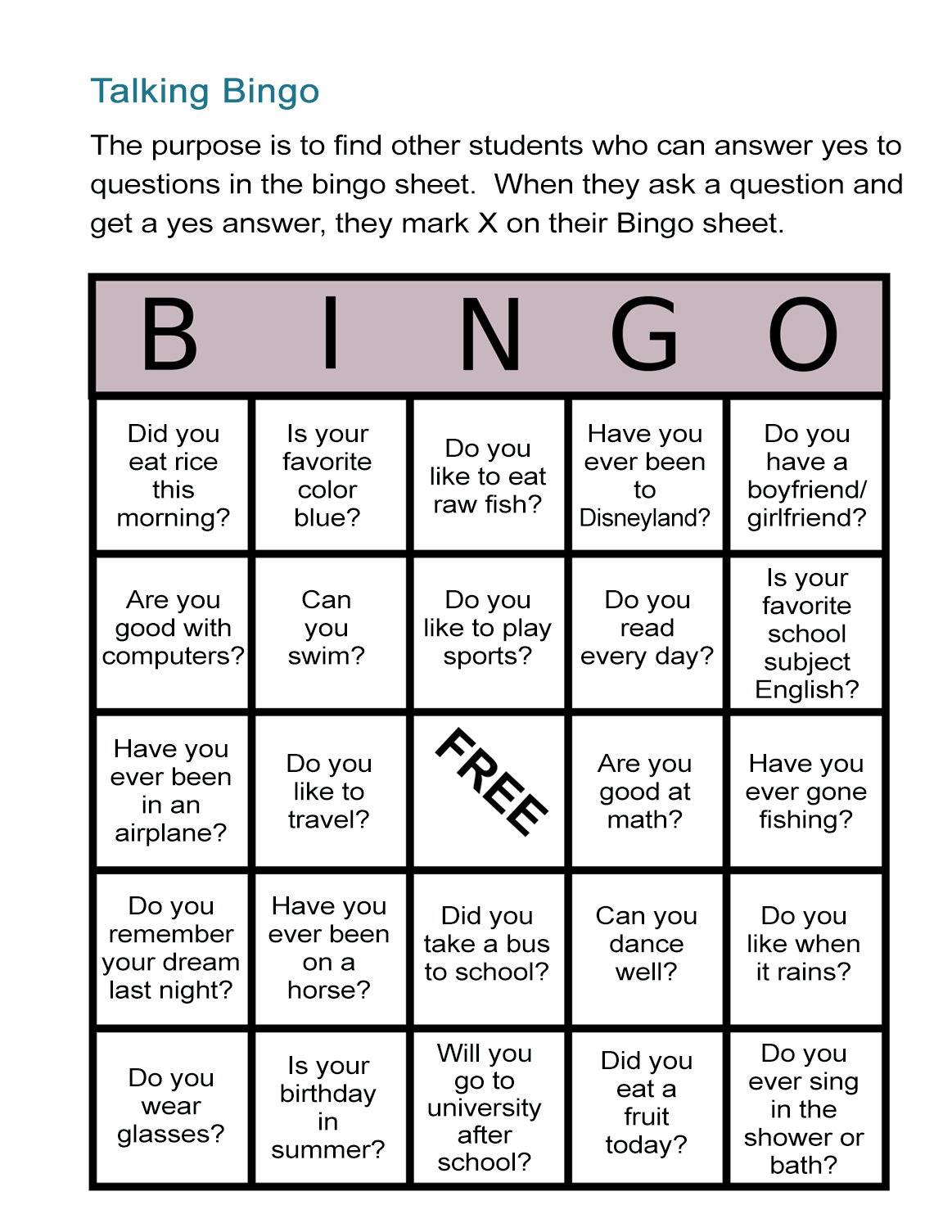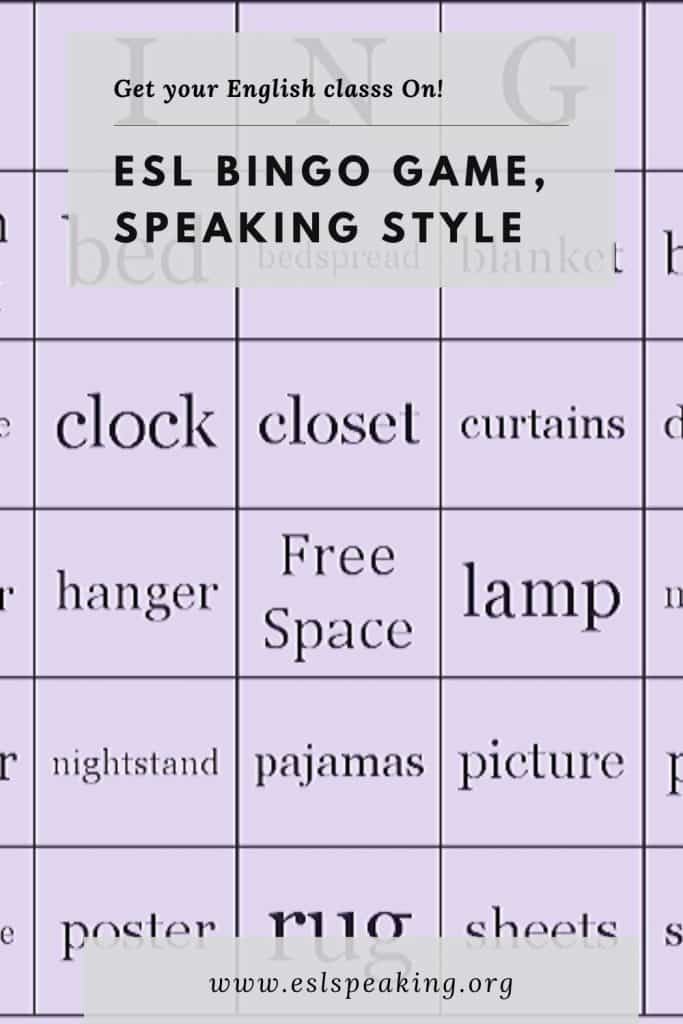Esl Bingo
This activity is to practice expressing likes and dislikes. The principle can be adapted, however, to practice almost any language item.
The game is best suited to medium to large groups of students. The objective is for each student to fill in a row of their bingo card with the signatures of classmates who have the same likes or dislikes as the pictures on the card. Once a student successfully obtains a full row (5 in a row), whether horizontally, vertically, or diagonally, they shout Bingo! and win.
The idea of having the students collect signatures is to make them formulate and ask key questions about the likes and dislikes featured on their cards but, as already said, this can be changed easily to different language items to suit the class.
A collection of downloadable worksheets, exercises and activities to teach Bingo, shared by English language teachers. Welcome to ESL Printables, the website where English Language. BINGO Games are a fun way to get your Newcomer ESL & Beginner ESL students to practice English Vocabulary. Choose to print the BINGO cards or assign the cards digitally.
NB If you aren’t sure what Bingo is, see the explanation at the bottom of the page.
Materials
Printed picture bingo cards and pens.

Prepare a 5 x 5 table, with interesting likes or dislikes printed in each box. Don’t write them but use pictures to suggest each like or dislike. This will allow students to form their own questions.
When creating the visual prompts be humorous and try to adapt the list of likes and dislikes to the type of students you have. For example with children you can be silly or play on things we all know they dislike – have a picture of a smelly pair of socks with a smiley face next to it to trigger statements like:
I like smelly socks!
If you are with teenagers play on the cool factor.
I like to gel my hair.
I hate school!
With adults you can use sarcasm or irony.
I like shopping for shoes with my wife.
I love paying taxes!
You can mark the center square FREE SPACE as in traditional BINGO games. After you have prepared the table, print out enough copies for the number of players you are expecting. Then prepare a legend everybody can refer to:
How to Play
Explain the game carefully to your students. Make sure the structures they will be using are familiar and go through them with the class so everyone understands how to make questions like:
Do you like football?
Do you dislike smelly socks?
Of course some pictures may be ambiguous but this doesn’t matter as each student will be able to create their own variation.
Explain the objective of the game and the following rules:
- you must keep your card turned away from the person you are asking
- you must ask the actual question using like, dislike, hate or love as indicted on the picture
- each person you talk to may only sign your card once, and to win, you must get signatures from 5 in a row horizontally, vertically, or diagonally
After you have checked everyone understands, hand out the cards, say “Ready, Steady, Go!” and the students begin.

As soon as someone shouts Bingo! everyone returns to their seats. The student who won must introduce the classmates who signed their card by giving at least one like or dislike for each student.
Alternatives & Variations
Esl Bingo Games Printable
- Replace some or all of the pictures in the picture bingo card with selected words to help students reinforce their vocabulary.
- Have different types of picture bingo cards aside from the traditional 5×5. Try smaller grids with lower level classes, for example.
- Select a theme and make sure your pictures relate to it.
- Print blank bingo cards and give students a variety of stickers to create their own. (This works best with children.)
- Give a theme to the ‘free space’ on the traditional 5×5 number bingo card.
Practicalities
Laminate your bingo cards after you print them and get students to sign using felt-tip pens so that they can be cleaned off afterwards. This simple trick will ensure your cards remain in good condition game after game.
What is Bingo?
Bingo is a game often played with a large number of people in halls or other venues. People are either given or purchase cards of 5 X 5 grids that have 25 total numbers on them. Each grid section has a number that is usually paired with letters that run across the top of the grid. A caller pulls out cards or uses bingo balls to call out each number. The players mark their spaces if they have the letter/number combination on their bingo grid card. The goal of bingo is to be the first to get five numbers in a row, horizontally, vertically or diagonally. When a person gets the five numbers, they shout out Bingo! and may be rewarded with prizes or money, or simply the satisfaction of winning.

This activity is to practice expressing likes and dislikes. The principle can be adapted, however, to practice almost any language item.
The game is best suited to medium to large groups of students. The objective is for each student to fill in a row of their bingo card with the signatures of classmates who have the same likes or dislikes as the pictures on the card. Once a student successfully obtains a full row (5 in a row), whether horizontally, vertically, or diagonally, they shout Bingo! and win.
The idea of having the students collect signatures is to make them formulate and ask key questions about the likes and dislikes featured on their cards but, as already said, this can be changed easily to different language items to suit the class.
NB If you aren’t sure what Bingo is, see the explanation at the bottom of the page.
Materials
Printed picture bingo cards and pens.
Esl Bingo Sheets
Prepare a 5 x 5 table, with interesting likes or dislikes printed in each box. Don’t write them but use pictures to suggest each like or dislike. This will allow students to form their own questions.
When creating the visual prompts be humorous and try to adapt the list of likes and dislikes to the type of students you have. For example with children you can be silly or play on things we all know they dislike – have a picture of a smelly pair of socks with a smiley face next to it to trigger statements like:
I like smelly socks!
If you are with teenagers play on the cool factor.
I like to gel my hair.
I hate school!
With adults you can use sarcasm or irony.
I like shopping for shoes with my wife.
I love paying taxes!
You can mark the center square FREE SPACE as in traditional BINGO games. After you have prepared the table, print out enough copies for the number of players you are expecting. Then prepare a legend everybody can refer to:
How to Play

Explain the game carefully to your students. Make sure the structures they will be using are familiar and go through them with the class so everyone understands how to make questions like:
Do you like football?
Do you dislike smelly socks?
Of course some pictures may be ambiguous but this doesn’t matter as each student will be able to create their own variation.
Explain the objective of the game and the following rules:
- you must keep your card turned away from the person you are asking
- you must ask the actual question using like, dislike, hate or love as indicted on the picture
- each person you talk to may only sign your card once, and to win, you must get signatures from 5 in a row horizontally, vertically, or diagonally
After you have checked everyone understands, hand out the cards, say “Ready, Steady, Go!” and the students begin.
As soon as someone shouts Bingo! everyone returns to their seats. The student who won must introduce the classmates who signed their card by giving at least one like or dislike for each student.
Alternatives & Variations
- Replace some or all of the pictures in the picture bingo card with selected words to help students reinforce their vocabulary.
- Have different types of picture bingo cards aside from the traditional 5×5. Try smaller grids with lower level classes, for example.
- Select a theme and make sure your pictures relate to it.
- Print blank bingo cards and give students a variety of stickers to create their own. (This works best with children.)
- Give a theme to the ‘free space’ on the traditional 5×5 number bingo card.

Practicalities
Laminate your bingo cards after you print them and get students to sign using felt-tip pens so that they can be cleaned off afterwards. This simple trick will ensure your cards remain in good condition game after game.
What is Bingo?
Bingo is a game often played with a large number of people in halls or other venues. People are either given or purchase cards of 5 X 5 grids that have 25 total numbers on them. Each grid section has a number that is usually paired with letters that run across the top of the grid. A caller pulls out cards or uses bingo balls to call out each number. The players mark their spaces if they have the letter/number combination on their bingo grid card. The goal of bingo is to be the first to get five numbers in a row, horizontally, vertically or diagonally. When a person gets the five numbers, they shout out Bingo! and may be rewarded with prizes or money, or simply the satisfaction of winning.